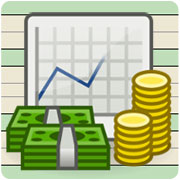
![]()
GnuCash version 2.6, released earlier this month, fixes many of the nagging problems in earlier versions and is more convenient to use.It tracks bank accounts, investments, income and expenses. You can use GnuCash just to handle your checking and savings accounts — but it is capable of doing much more.

GnuCash is based on professional accounting principles to ensure balanced books and accurate reports. If you venture beyond basic banking registers, you might find its double entry bookkeeping procedures a bit intimidating. In short, every transaction must be entered as a debit in one account and as a credit in the same amount in a corresponding account.
Version 2.6 has an improved user interface for the checkbook register.

Its multiplatform support — there are versions for Linux, OS X, Windows, BSD and Solaris — offers users flexibility for both personal and small business use. This latest version is licensed under the expanded terms of GNU GPLv2+.
One of GnuCash’s most significant improvements is the ability to save financial data in an SQL database using SQLite3, MySQL or PostgreSQL.
Feature Rich
Not all money applications cater to users’ needs for customizing graphs and reports to the extent that GnuCash does. For example, an integrated module displays graphs of your financial data in bar charts, pie charts or scatter plots. A full suite of standard and customizable reports includes balance sheet, profit and loss and portfolio valuation.
A statement reconciliation feature provides a running summary of how each transaction impacts the bank statement. The bottom line of the register shows the present balance, the new balance when the transaction entry is completed, the cleared and reconciled balances, and the projected minimum in the account.
This feature makes it very simple to compare the transactions you enter in an account against that account’s bank statement. This is a very useful way to spot untracked transactions or data entry errors.
Income/expense account types — what other financial apps typically refer to as “categories” — let you categorize your cash flow. If you lack a bookkeeping background, this is one part of GnuCash that can make the program confusing to use. It applies the double-entry method that creates accurate reports, going beyond what other banking apps can do.

Business Class
GnuCash is an ideal application if you run a small business or operate mostly from a home office. This ability to manage business transactions is another advantage to GnuCash over other applications.
Its additional features let you track customer and vendor accounts, handle invoicing and bill payment options, and monitor tax and billing terms. GnuCash also provides a tool to manage a business budget, so you can easily plan your financial strategy.
As part of an integrated package for small businesses, the multiple currency feature can be a great tool. You can use it to track currency movements between accounts when double-entry is enabled.
Stock Management
GnuCash also has a module for tracking stocks individually. You can use one module per account or combine multiple investments into a portfolio displaying all accounts together.
You can also use GnuCash to get stock and mutual fund quotes from websites to automatically update the portfolio. The program updates pricing sources regularly.
Saving Factors
GnuCash stores data in an .xml file format by default. Swapping data in and out of financial applications is always a chancy operation.
In theory, GnuCash imports data from other applications that output files in QIF (Quicken format) or OFX (Open financial Exchange) formats. In practice, I had trouble getting my banking data from exported files created by several spreadsheet and banking applications.
GnuCash also supports the German Home Banking Computer Information protocol (HBCI). For international users, this can make GnuCash well worth adopting.
Getting It
The tweaks and bug fixes alone make GnuCash Version 2.6 a much improved product. However, getting it can be problematic — you might have to wait until it is more readily available through your Linux distro’s software repository.
I was not able to find this latest release in software centers for Ubuntu, Linux Mint and SolydXK distros or in the Synaptic Package Manager. Typically, distro repositories lag behind by several release cycles. That leaves you no option but the developer’s website.
Getting GnuCash 2.6 directly from the developer’s website can be an exercise in frustration for Linux users. It is available only in tarball format. Uncompressing the .tar.bz2 file and then compiling it for manual installation may be beyond many users’ skill sets.
Bottom Line
GnuCash can be overkill if all you need is a checkbook register tool.
You can easily use just the checking account module and be very happy with it. For more detailed household financial management, the general ledger module will get you equally pleasing results.
Even casual users can get a lot of payouts from GnuCash’s basic feature set. You can print checks in standard formats on common check stocks. You can easily customize check layouts.
You can graduate to GnuCash’s business and financial-tracking features as you need them. However, you may have to spend some time reviewing the user guide to get to know what you’re doing with these advanced features.
Want to Suggest a Linux Application for Review?
Is there a Linux software application you’d like to suggest for review? Something you love or would like to get to know?
Please email your ideas to me, and I’ll consider them for a future Linux Picks and Pans column.
And use the Talkback feature below to add your comments!




















































